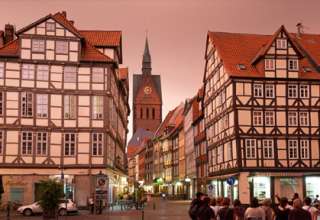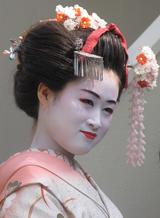Traveling Boy looks back at one of our travel writers who has since passed away. Although she is no longer with us physically, she is still close to our hearts … especially through the memories of her life adventures. Thank you Dette for sharing your adventures. A TBoy traveler of yesteryear. — TBoy Editor

Dette Pascual
Photos courtesy of Rene Pernia, Iligan City Tourism Office
Viva! September in Iligan City, island of Mindanao, Philippines, is fiesta time. The Iligan fiesta is focused on Michael, “an archangel in Jewish, Christian and Islamic tradition. He is viewed as the field commander of the Army of God against the Devil’s forces during Lucifer’s uprising in heaven.” (Wikipedia)

Attending the celebrations after years of staying abroad, I was brought back to nostalgia. The tradition of bringing down the ancient statue of Saint Michael to the main altar for main viewing on the first day of the novena, started the festivities with a bang. Literally!
There were heated discussions among the parishioners whether the ritual of putting on the helmet, cape and sword of Saint Michael as he is brought down should be followed or not. Traditionally, the honor of dressing the statue was always given to the town fathers. This time however, the bishop wanted to emphasize the separation of Chuch and State. The ceremonial donning of helmet, cape and sword was omitted.
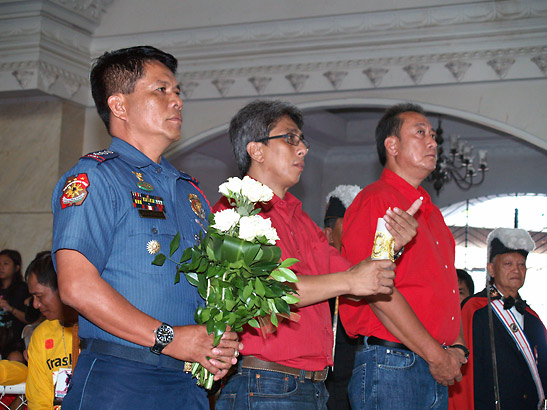
The new ritual lead participants from the civil side: Iligan City Police Chief, Senior Supt. Celso Regencia holds the bunch of flowers, symbol of peace, that he will offer at the altar; Mayor Cruz is ready to go to the altar with his offering of lighted candle; Rep. Belmonte has just returned from offering the Holy Bible, quite in contrast to the ritual in previous years.
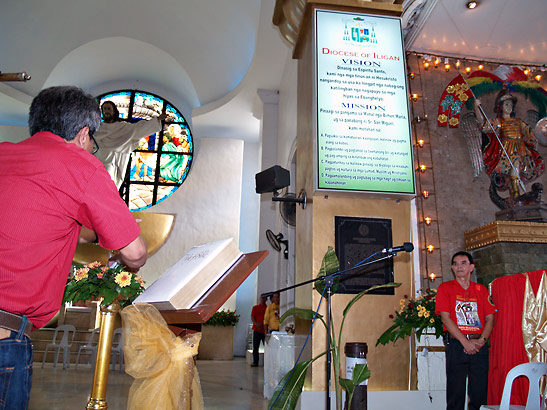
Before Vatican Council II, the image of the patron saint was the dominant icon in the altar of the Catholic Church. At the Iligan Cathedral today, the image of the Risen Lord dominates. (That is Mayor Cruz offering the lighted candle.)
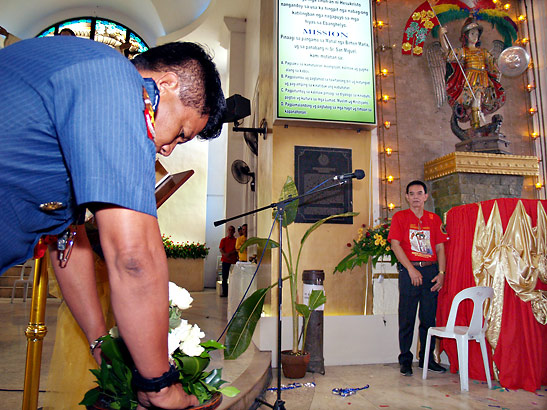
The image of the patron saint is up the right side of the altar. Pagpakanaug refers to transferring the image to a lower platform, for easier access when taking it out for the procession, and also to put it within reach of the venerating faithful.
There are always two sides of the question. “Tradition!” shouted one side. “Politics!”said the other. The dilemma of tradition pitted against modern times, is as old as when men started to organize themselves as a social unit.
In the end, when all was said and done, a reasonable balance of power prevailed. The dressing up of the statue was done already when it was brought down to the altar, so there was no need for the Mayor and other government officials to take center stage and do the honors. Instead, the dignitaries were given place during the offertory of the Catholic Mass that followed. The Mayor, the Congressman, and the Chief of Police marched down the altar bearing symbols. The congressman carried the bible, the Mayor held a lighted candle, and the City Police Director had flowers. The latter was worth noting because the flowers symbolized peace.
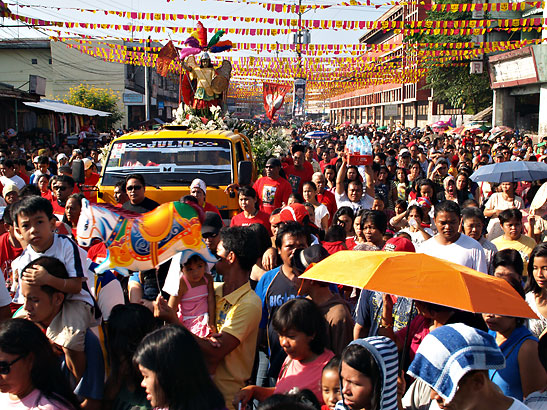
In less than one hour the procession was over, from the Cathedral on Quezon Avenue, turned right to Cabili Avenue, right to Sabayle Street, left on Mariano Badelles Street, right on Roxas Avenue, right to Quezon Avenue back to the Cathedral. Photo shows the 6-lane Cabili filled by the participants. The 6 a.m. procession was faster because the image of Saint Michael the Archangel was this time positioned on a vehicle, instead of the human-pulled carriage as was done in the past.
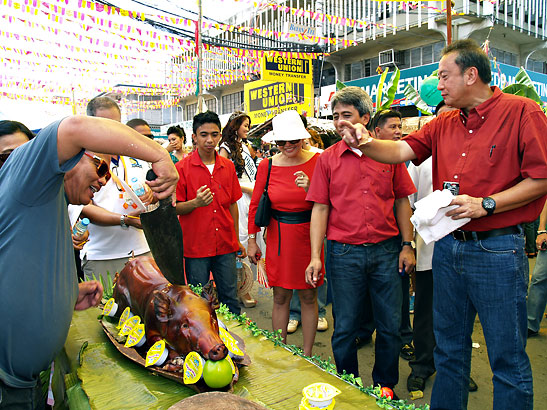
Rep. Belmonte and Mayor Cruz watch the chopping up of this lechon (roasted pig), one of the 60 in the contest, to be eaten by the fiesta goers on Pagpakanaug Day, Sept. 20. This lechon festival is an idea of Councilor Marlene Young in support of Iligan’s Lechon Industry.
The rest of the traditions went on… the street dancing, the pageantry of costumes, the culminating drama of the fight of the good angels led by Saint Michael, against the bad angels who followed Lucifer. It ended with the glorious victory of God’s forces of Light. All’s well that ends well. Viva, Senor San Miguel!
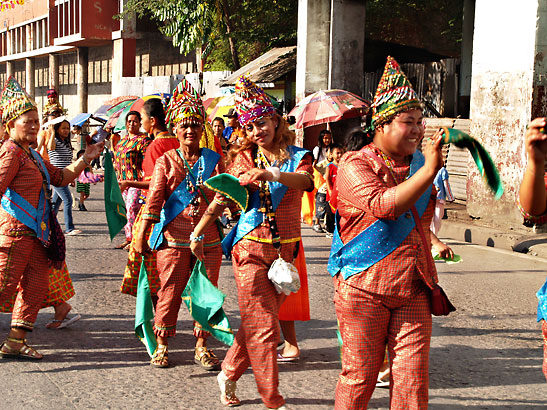
Diyandi male dancers
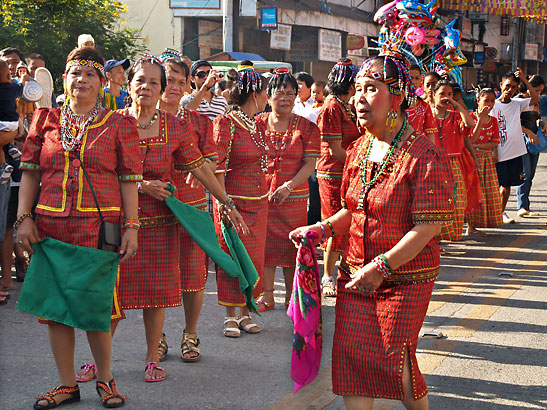
Diyandi female dancers of the Higaunon tribe, natives of Iligan. Some have converted to Islam, some to Catholicism.
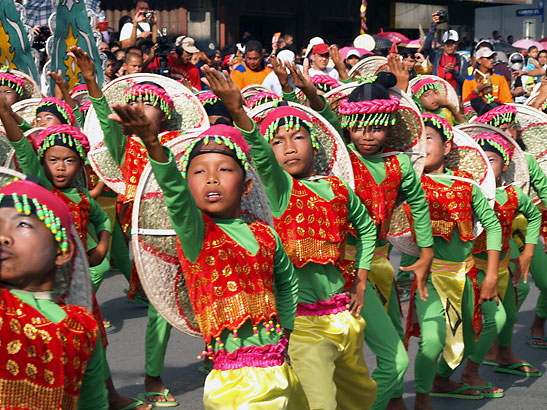
Young school children from Balabagan, Lanao del Sur, a town with a predominantly Maranao (Muslim) population, won first prize in the KSD contest. Note the locally manufactured handicrafts and attire won by the participants.
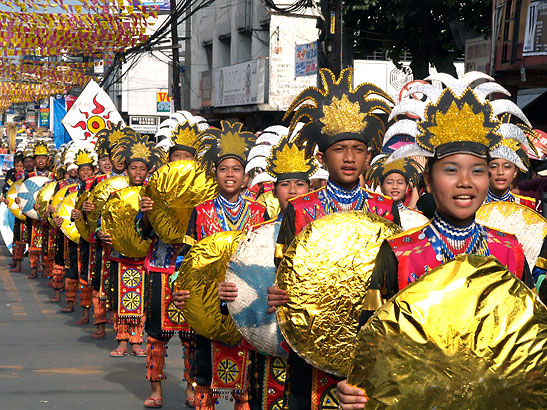
The Kiwalan street dancers won third prize.
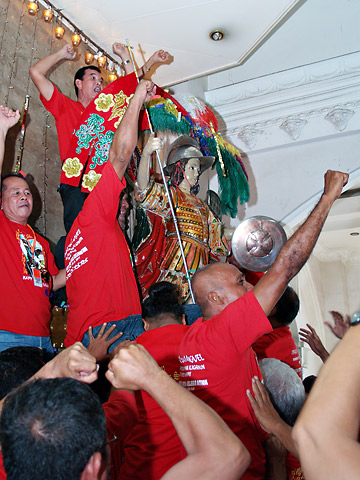
For many decades, the Pagpakanaug ritual called for the taking down of San Miguel’s helmet to be handed to the Congressman, the spear to be handed to the mayor and the shield to be handed to the Chief of Police The image is now “lowered” without a change in vestment; the offering of the flower, the candle and the Holy Bible is now set in place.
During one of the many celebration parties we attended, the conversation centered on the traditions in Iligan City which have faded away from memory. One of the lamented ones was the ringing of the church bells during angelus, which was 6:00 AM, 12:00 PM, and 6:00 PM everyday. It used to be that wherever they are, or whatever they happened to be doing, people would stop when the bells rung. They bowed their heads in silence and pray the Hail Mary angelus to honor the Virgin Mother. This only took a few minutes, but the pause was enough to remind the faithful of God’s presence in each life.
I remember, as a child, that wherever my brothers and I would be, as soon as we heard the Angelus, we ran as fast as we could for home. If we arrived late for prayers, we were made to kneel an hour before the altar with our arms outstretched. (Not really an hour, because in those days, no one watched the clock.) The humiliation and the younger cousins smirking at our ordeal, was enough to shame us not to be late again. In retrospect, I believe this was a good way for parents to check that the children were home before dark. Perhaps, if we still had that custom now, there would be less juvenile crime. Who knows?
Another way of checking on the older children, was the ringing of church bells at 8:00 PM. Unlike the angelus bells, this time, the bells sounded solmemn. “Gong! Gong! Gong!” To my child’s mind, it said, “The evil spirits will be roaming now. Go to bed! Go to bed!” My Mama would then tell us that it was time to say our good night prayers.
I liked it best when it was my grandma, Lola Ica, who would tuck me to bed. She taught me this prayer in Visayan. “Angel kong magbalantay/ Santos kong sangay/ Imo akong bantayan/ Sa akong pagkatulog. Sa ulo ko ug ti-ilan / sa sigkakilid ko magtimbang / Si Jesus and akong guimatan….” The gist of the prayer was asking for God’s grace and requesting Him to send angels to watch over my sleep, with Jesus above me, Mary and Joseph on each side. Then I would shiver under my blankets so grateful to be snug in bed , well protected. I felt so safe and secure then.
Speaking of Lola Ica, there is another tradition which makes me remember her so fondly. It was the “cantada.” Whenever it was the birthday of anyone in the family, she would wake up at dawn, then light the candles at the altar and wake everyone up. We would come in one by one, sometimes grumbling, sometimes just drowsily drop to the floor in front of the altar and go on sleeping. But we kids would soon awaken to the sound of singing. It was the “cantada” led by Lola Ica. With a strong voice she led the singing of praise to God, to thank him for the birth of —- (Here, she would mention the name of the birthday celebrant) — for making him part of our lives. Then everyone joins in the singing of praises to God, his angels, his saints , followed by the Ave Maria.
Looking back, I see now the importance of the cantada in the family. It made each one who celebrates a birthday feel esteemed. One may have rough times or feel ignored in the family at certain times in the year. But when one’s birthday comes, we can be sure that everyone remembers. As the family prays together for you and your life, you feel important. The mellow voices soft in the cool dawn, the candles lit on a dim altar; the lightening sky seen through the window; and the solemn faces of family members who gave up their sleep to thank God for you… What a manifestation of family love.
Thus, we in that party talked of tradition. But actually, I think, we were thinking and missing the family ties and community customs that held us when we were growing up. That life style only lives in memory now. But those of our generation who were part of it will always remember, and smile. Viva fiesta!
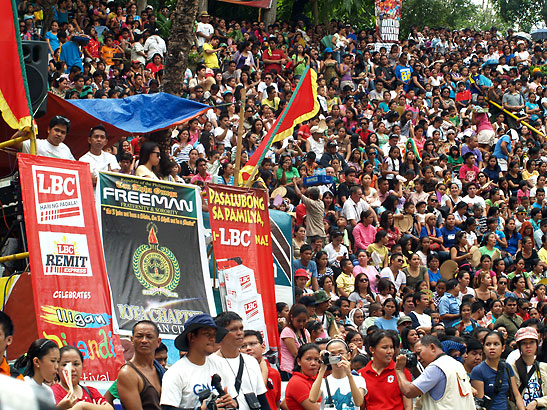
Part of the crowd that listened to the mayor at the Anahaw Amphitheatre near the city hall.


